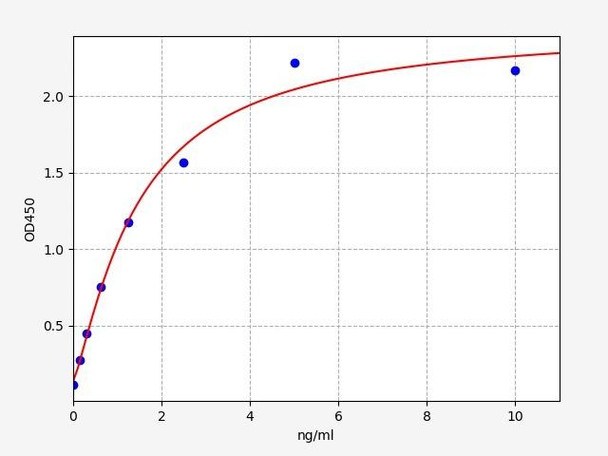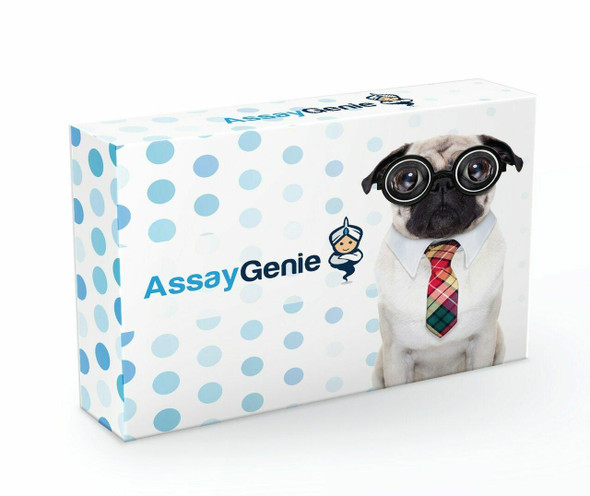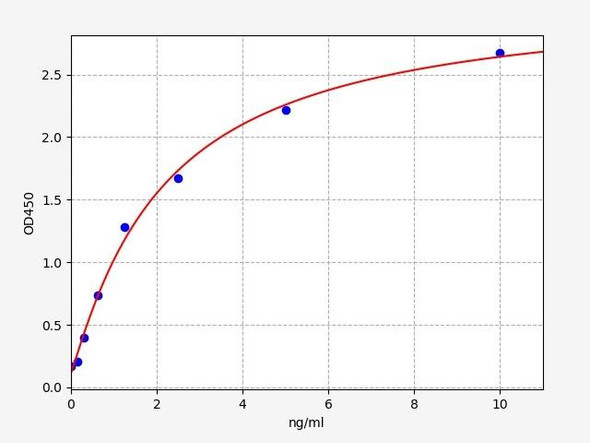Human PPP2R4 (Serine/threonine-protein phosphatase 2A activator) ELISA Kit (HUFI08099)
- SKU:
- HUFI08099
- Product Type:
- ELISA Kit
- Size:
- 96 Assays
- Uniprot:
- Q15257
- Sensitivity:
- 0.094ng/ml
- Range:
- 0.156-10ng/ml
- ELISA Type:
- Sandwich
- Synonyms:
- PP2A, PP2A, subunit B, PR53 isoform, PPP2R4, PR53, PTPA
- Reactivity:
- Human
Description
Human PPP2R4 (Serine/threonine-protein phosphatase 2A activator) ELISA Kit (HUFI08099)
The Human PPP2R4 (Serine/Threonine Protein Phosphatase 2A Activator) ELISA Kit is specifically designed for the accurate measurement of PPP2R4 levels in human samples such as serum, plasma, and cell culture supernatants. This kit offers exceptional sensitivity and specificity, ensuring precise and reproducible results for a variety of research applications.PPP2R4 is a critical regulator of the protein phosphatase 2A (PP2A) enzyme, which plays a key role in cellular signaling pathways and various biological processes.
Dysregulation of PP2A activity has been linked to several diseases, including cancer, Alzheimer's disease, and diabetes, making PPP2R4 a valuable biomarker for studying these conditions and developing potential therapeutic interventions.Overall, the Human PPP2R4 ELISA Kit provides researchers with a valuable tool for investigating the role of PPP2R4 in disease pathology and discovering new opportunities for targeted treatments.
| Product Name: | Human PPP2R4 (Serine/threonine-protein phosphatase 2A activator) ELISA Kit |
| Product Code: | HUFI08099 |
| Size: | 96 Assays |
| Alias: | PP2A ELISA Kit, PP2A ELISA Kit, subunit B ELISA Kit, PR53 isoform ELISA Kit, PPP2R4 ELISA Kit, PR53 ELISA Kit, PTPA ELISA Kit |
| Detection method: | Sandwich ELISA, Double Antibody |
| Application: | This immunoassay kit allows for the in vitro quantitative determination of Human PPP2R4 (Serine/threonine-protein phosphatase 2A activator) concentrations in serum plasma and other biological fluids. |
| Sensitivity: | < 0.094ng/ml |
| Range: | 0.156-10ng/ml |
| Storage: | 4°C for 6 months |
| Note: | For Research Use Only |
| Recovery: | Matrices listed below were spiked with certain level of Human PPP2R4 (Serine/threonine-protein phosphatase 2A activator) and the recovery rates were calculated by comparing the measured value to the expected amount of Human PPP2R4 (Serine/threonine-protein phosphatase 2A activator) in samples. Enquire for more information. |
| Linearity: | The linearity of the kit was assayed by testing samples spiked with appropriate concentration of Human PPP2R4 (Serine/threonine-protein phosphatase 2A activator) and their serial dilutions. The results were demonstrated by the percentage of calculated concentration to the expected. Enquire for more information. |
| CV(%): | Intra-Assay: CV<8% Inter-Assay: CV<10% |
| Component | Quantity | Storage |
| ELISA Microplate (Dismountable) | 8×12 strips | 4°C for 6 months |
| Lyophilized Standard | 2 | 4°C/-20°C |
| Sample/Standard Dilution Buffer | 20ml | 4°C |
| Biotin-labeled Antibody(Concentrated) | 120ul | 4°C (Protect from light) |
| Antibody Dilution Buffer | 10ml | 4°C |
| HRP-Streptavidin Conjugate(SABC) | 120ul | 4°C (Protect from light) |
| SABC Dilution Buffer | 10ml | 4°C |
| TMB Substrate | 10ml | 4°C (Protect from light) |
| Stop Solution | 10ml | 4°C |
| Wash Buffer(25X) | 30ml | 4°C |
| Plate Sealer | 5 | - |
Other materials and equipment required:
- Microplate reader with 450 nm wavelength filter
- Multichannel Pipette, Pipette, microcentrifuge tubes and disposable pipette tips
- Incubator
- Deionized or distilled water
- Absorbent paper
- Buffer resevoir
| UniProt Protein Function: | PPP2R4: PPIases accelerate the folding of proteins. It catalyzes the cis-trans isomerization of proline imidic peptide bonds in oligopeptides. Acts as a regulatory subunit for serine/threonine- protein phosphatase 2A (PP2A) modulating its activity or substrate specificity, probably by inducing a conformational change in the catalytic subunit, a proposed direct target of the PPIase. Can reactivate inactive phosphatase PP2A-phosphatase methylesterase complexes (PP2A(i)) in presence of ATP and Mg(2+). Reversibly stimulates the variable phosphotyrosyl phosphatase activity of PP2A core heterodimer PP2A(D) in presence of ATP and Mg(2+) (in vitro). The phosphotyrosyl phosphatase activity is dependent of an ATPase activty of the PP2A(D):PPP2R4 complex. Is involved in apoptosis; the function appears to be independent from PP2A. Associates with PP2A heterodimeric core enzyme PP2A(D), composed of a 36 kDa catalytic subunit (subunit C) and a 65 kDa constant regulatory subunit (PR65 or subunit A). Interacts with PPP2CB. Widely expressed. Belongs to the PTPA-type PPIase family. 4 isoforms of the human protein are produced by alternative splicing. |
| UniProt Protein Details: | Protein type:Motility/polarity/chemotaxis; EC 5.2.1.8; Protein phosphatase, regulatory subunit Chromosomal Location of Human Ortholog: 9q34 Cellular Component: nucleoplasm; protein phosphatase type 2A complex; cytoplasm; nucleus Molecular Function:peptidyl-prolyl cis-trans isomerase activity; protein homodimerization activity; protein phosphatase 2A binding; protein heterodimerization activity; ATPase activity; protein phosphatase type 2A regulator activity; ATP binding; protein tyrosine phosphatase activator activity; receptor binding Biological Process: positive regulation of phosphoprotein phosphatase activity; negative regulation of protein amino acid dephosphorylation; protein peptidyl-prolyl isomerization; positive regulation of apoptosis; metabolic process; mitotic spindle organization and biogenesis in nucleus; negative regulation of phosphoprotein phosphatase activity; regulation of phosphoprotein phosphatase activity; positive regulation of protein amino acid dephosphorylation |
| NCBI Summary: | Protein phosphatase 2A is one of the four major Ser/Thr phosphatases and is implicated in the negative control of cell growth and division. Protein phosphatase 2A holoenzymes are heterotrimeric proteins composed of a structural subunit A, a catalytic subunit C, and a regulatory subunit B. The regulatory subunit is encoded by a diverse set of genes that have been grouped into the B/PR55, B'/PR61, and B''/PR72 families. These different regulatory subunits confer distinct enzymatic specificities and intracellular localizations to the holozenzyme. The product of this gene belongs to the B' family. This gene encodes a specific phosphotyrosyl phosphatase activator of the dimeric form of protein phosphatase 2A. Alternative splicing results in multiple transcript variants encoding different isoforms. [provided by RefSeq, Jul 2008] |
| UniProt Code: | Q15257 |
| NCBI GenInfo Identifier: | 116242737 |
| NCBI Gene ID: | 5524 |
| NCBI Accession: | Q15257.3 |
| UniProt Related Accession: | Q15257 |
| Molecular Weight: | |
| NCBI Full Name: | Serine/threonine-protein phosphatase 2A activator |
| NCBI Synonym Full Names: | protein phosphatase 2 phosphatase activator |
| NCBI Official Symbol: | PTPA |
| NCBI Official Synonym Symbols: | PP2A; PR53; PPP2R4 |
| NCBI Protein Information: | serine/threonine-protein phosphatase 2A activator |
| UniProt Protein Name: | Serine/threonine-protein phosphatase 2A activator |
| UniProt Synonym Protein Names: | PP2A, subunit B', PR53 isoform; Phosphotyrosyl phosphatase activator; PTPA; Serine/threonine-protein phosphatase 2A regulatory subunit 4; Serine/threonine-protein phosphatase 2A regulatory subunit B' |
| Protein Family: | Prolyl tripeptidyl peptidase |
| UniProt Gene Name: | PPP2R4 |
| UniProt Entry Name: | PTPA_HUMAN |
*Note: Protocols are specific to each batch/lot. For the correct instructions please follow the protocol included in your kit.
Before adding to wells, equilibrate the SABC working solution and TMB substrate for at least 30 min at 37 °C. When diluting samples and reagents, they must be mixed completely and evenly. It is recommended to plot a standard curve for each test.
| Step | Protocol |
| 1. | Set standard, test sample and control (zero) wells on the pre-coated plate respectively, and then, record their positions. It is recommended to measure each standard and sample in duplicate. Wash plate 2 times before adding standard, sample and control (zero) wells! |
| 2. | Aliquot 0.1ml standard solutions into the standard wells. |
| 3. | Add 0.1 ml of Sample / Standard dilution buffer into the control (zero) well. |
| 4. | Add 0.1 ml of properly diluted sample ( Human serum, plasma, tissue homogenates and other biological fluids.) into test sample wells. |
| 5. | Seal the plate with a cover and incubate at 37 °C for 90 min. |
| 6. | Remove the cover and discard the plate content, clap the plate on the absorbent filter papers or other absorbent material. Do NOT let the wells completely dry at any time. Wash plate X2. |
| 7. | Add 0.1 ml of Biotin- detection antibody working solution into the above wells (standard, test sample & zero wells). Add the solution at the bottom of each well without touching the side wall. |
| 8. | Seal the plate with a cover and incubate at 37 °C for 60 min. |
| 9. | Remove the cover, and wash plate 3 times with Wash buffer. Let wash buffer rest in wells for 1 min between each wash. |
| 10. | Add 0.1 ml of SABC working solution into each well, cover the plate and incubate at 37 °C for 30 min. |
| 11. | Remove the cover and wash plate 5 times with Wash buffer, and each time let the wash buffer stay in the wells for 1-2 min. |
| 12. | Add 90 µL of TMB substrate into each well, cover the plate and incubate at 37 °C in dark within 10-20 min. (Note: This incubation time is for reference use only, the optimal time should be determined by end user.) And the shades of blue can be seen in the first 3-4 wells (with most concentrated standard solutions), the other wells show no obvious color. |
| 13. | Add 50 µL of Stop solution into each well and mix thoroughly. The color changes into yellow immediately. |
| 14. | Read the O.D. absorbance at 450 nm in a microplate reader immediately after adding the stop solution. |
When carrying out an ELISA assay it is important to prepare your samples in order to achieve the best possible results. Below we have a list of procedures for the preparation of samples for different sample types.
| Sample Type | Protocol |
| Serum | If using serum separator tubes, allow samples to clot for 30 minutes at room temperature. Centrifuge for 10 minutes at 1,000x g. Collect the serum fraction and assay promptly or aliquot and store the samples at -80°C. Avoid multiple freeze-thaw cycles. If serum separator tubes are not being used, allow samples to clot overnight at 2-8°C. Centrifuge for 10 minutes at 1,000x g. Remove serum and assay promptly or aliquot and store the samples at -80°C. Avoid multiple freeze-thaw cycles. |
| Plasma | Collect plasma using EDTA or heparin as an anticoagulant. Centrifuge samples at 4°C for 15 mins at 1000 × g within 30 mins of collection. Collect the plasma fraction and assay promptly or aliquot and store the samples at -80°C. Avoid multiple freeze-thaw cycles. Note: Over haemolysed samples are not suitable for use with this kit. |
| Urine & Cerebrospinal Fluid | Collect the urine (mid-stream) in a sterile container, centrifuge for 20 mins at 2000-3000 rpm. Remove supernatant and assay immediately. If any precipitation is detected, repeat the centrifugation step. A similar protocol can be used for cerebrospinal fluid. |
| Cell culture supernatant | Collect the cell culture media by pipette, followed by centrifugation at 4°C for 20 mins at 1500 rpm. Collect the clear supernatant and assay immediately. |
| Cell lysates | Solubilize cells in lysis buffer and allow to sit on ice for 30 minutes. Centrifuge tubes at 14,000 x g for 5 minutes to remove insoluble material. Aliquot the supernatant into a new tube and discard the remaining whole cell extract. Quantify total protein concentration using a total protein assay. Assay immediately or aliquot and store at ≤ -20 °C. |
| Tissue homogenates | The preparation of tissue homogenates will vary depending upon tissue type. Rinse tissue with 1X PBS to remove excess blood & homogenize in 20ml of 1X PBS (including protease inhibitors) and store overnight at ≤ -20°C. Two freeze-thaw cycles are required to break the cell membranes. To further disrupt the cell membranes you can sonicate the samples. Centrifuge homogenates for 5 mins at 5000xg. Remove the supernatant and assay immediately or aliquot and store at -20°C or -80°C. |
| Tissue lysates | Rinse tissue with PBS, cut into 1-2 mm pieces, and homogenize with a tissue homogenizer in PBS. Add an equal volume of RIPA buffer containing protease inhibitors and lyse tissues at room temperature for 30 minutes with gentle agitation. Centrifuge to remove debris. Quantify total protein concentration using a total protein assay. Assay immediately or aliquot and store at ≤ -20 °C. |
| Breast Milk | Collect milk samples and centrifuge at 10,000 x g for 60 min at 4°C. Aliquot the supernatant and assay. For long term use, store samples at -80°C. Minimize freeze/thaw cycles. |









